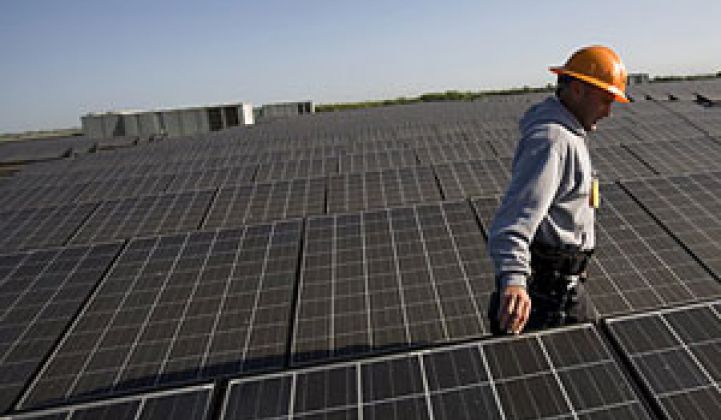Will solar be a lot cheaper in two years?
Maybe, says Erik Zech, chief financial officer of installer Real Goods Solar.
It's not the kind of answer you expect to hear. Technology is always supposed to go down in price. If the auto industry operated on the principles of Moore's Law, the comparison goes, a Rolls Royce would cost $1.50 and be capable of going from zero to 60 in less than four seconds. (It would also only be about two inches long, but you get the point.)
To top it off, solar panel manufacturers are struggling with a glut of manufacturing capacity. Suntech Power Holdings, the Big Chinese solar manufacturer, says it will likely only put out 800 megawatts of solar this year, although it has capacity for 1 gigawatt.
So where are the massive price cuts? And when should you buy?
It's a tough question, it turns out. Chalk it up to the vagaries of the market. When it comes to pricing a home system, there are a lot of moving parts to consider, say installers – labor, raw materials, land, credit, shipping, etc.
Silicon prices, for instance, continue to plummet and panel makers are figuring out ways to make panels with less silicon. Partly as a result, panels are down to around $2.50 a watt, says Jeffrey Wolfe, CEO of groSolar, another installer.
"We have returned to a 2004 pre-silicon shortage level," he said.
Still, installing a solar system costs around $7 a watt in California, he said. That's lower than the past, but t he price isn't dropping nearly as fast as panel prices.
Technology, at least at the moment, may not help much either. Thin-film panels cost less. However, they also produce less power and end up adding about 50 cents per watt in installation, Wolfe said. More math problems, anyone?
Ironically, subsidies have helped maintain the price. In California, the residential solar subsidy started at $2.50 a watt, but has steadily declined as more panels get installed. In Northern California it is down to $1.55 a watt and will drop to $1.10 a watt after 16 more megawatts are installed. Panel and installation prices may drop, but that decline in rebates eliminates the effect.
"The best time to buy solar in San Francisco was last December," said Lyndon Rive, CEO of Solar City.
Real Goods has a chart showing that a 4-kilowatt home system drops from around $27,519 around a year ago to $19,263 today. The difference? The $8,256 federal credit. Take that out and the numbers are equal.
There are, however, changes coming down the pike. Akeena Solar, Armageddon Energy and others are going to attempt to take a big chunk out of the cost with Do-It-Yourself solar. These companies plan to sell panels already coupled with micro-inverters, the thing that converts DC to AC power, and easier-to-use prepackaged framing and wiring.
Solar panels weigh quite a bit, so you will need the help of the neighbors, but it could reduce the need for professional help. Installation accounts for 33 to nearly 50 percent of the cost of a solar system. Potentially, you could buy a kit at Home Depot screw in the panels and plug it in yourself.
"The potential installation savings are huge. It is transformational," said Barry Cinnamon, CEO of Akeena, adding that DIY could reduce the cost of solar from $7.40 watts now, all in, to $2.80 a watt in 18 months. Put another way, that would reduce solar electricity from 17 cents a kilowatt hour today to 7 cents, or very close to coal.
The proliferation of state programs will also help, said Wolfe. California and New Jersey aren't next to each other. However, now contiguous states have solar programs, which lets dealers can exploit differences in supply, demand and subsidies.
"We're seeing interesting leverages we haven't seen before," he said.
The price of standard electricity should also go down as manufacturing improves.
Suntech, for instance, is cranking up its Pluto solar cells (see Pluto: Suntech's Shot at Technical Glory). Pluto cells are more efficient than standard Suntech cells, achieving a 17 percent to 19 percent efficiency on the cell level. "But they cost no more to produce," said Steve Chadima, vice president of external affairs. Suntech can sell these for higher margins now, but it also gives them wiggle room in a price war.
By 2012, solar systems could drop from $7 a watt to $4 a watt, he said.
Is it possible? Sure, but what if states have to start cutting programs, or stories about bad installs begin to sprout on the Web?
As Wolfe says, "We've never had a stable market."



